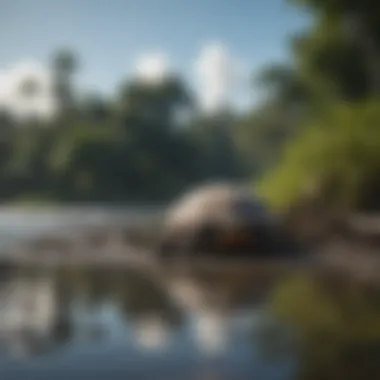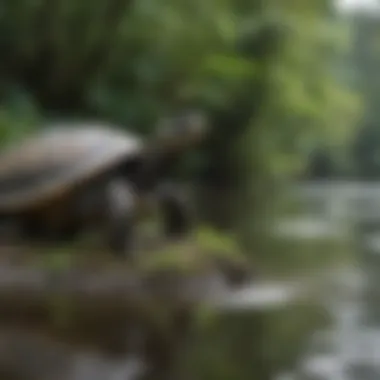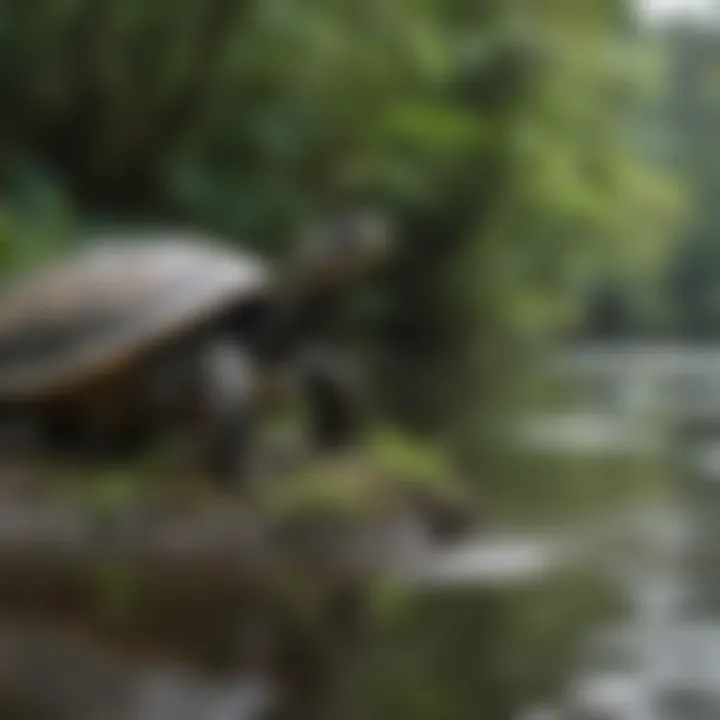Tortuguero, Costa Rica: A Turtle Paradise


Intro
Tortuguero, Costa Rica, is a captivating area renowned for its vibrant biodiversity, particularly its vital role as a sanctuary for turtles. This unique location is not only a crucial habitat for various turtle species but also offers an intricate ecosystem that supports both marine and freshwater life. The region attracts researchers, conservationists, and eco-tourists alike, all drawn by the allure of observing these magnificent creatures in their natural habitat.
Understanding Tortuguero requires an exploration of its geographical features, climatic conditions, and the specific species of turtles that grace its shores and waters. With significant nesting sites and conservation initiatives underway, this area stands as a beacon of hope for turtle populations threatened by numerous human activities.
As we delve into the features that define Tortuguero, we will examine the nesting behaviors of the turtles that inhabit this sanctuary. The challenges faced by these reptiles, alongside the ecological impacts of their interactions with human populations, are also critical components of our discussion. Equally important is the role of eco-tourism, which can either help sustain conservation efforts or pose risks to the already delicate ecosystem.
Through this exploration, we aim to enlighten a diverse audience about the complexities of marine conservation and the ongoing efforts to protect the sanctuary of Tortuguero.
Prolusion to Tortuguero
Tortuguero is a vital ecological area in Costa Rica, notably recognized for its extensive role in turtle conservation. This introduction highlights the significance of Tortuguero as a sanctuary for various turtle species and emphasizes the interconnectedness of the local ecosystem. The unique biodiversity found here is paramount, not only for conservationists but also for researchers and educators. Understanding the geographical context and historical significance of this area enriches the narrative surrounding its role in environmental sustainability.
Geographical Context
Tortuguero is situated on the Caribbean coast of Costa Rica, surrounded by a labyrinth of canals and wetlands. This geographical layout creates a distinct ecosystem with both marine and freshwater habitats. The lush tropical rainforest and coastal beaches contribute to the region's rich biodiversity. The area is remote, accessible primarily by boat or small plane, which has aided in preserving its unique environment. The climate is tropical, featuring high humidity and frequent rainfall, fostering lush vegetation that supports various wildlife.
Key geographical features include:
- A network of lagoons and canals
- Diverse marine environments
- Coastal habitats that are crucial for nesting turtles
These elements not only facilitate turtle nesting but also attract a multitude of other species, creating a delicate balance in the ecosystem.
Historical Significance
The historical backdrop of Tortuguero is rich and complex. Initially, it was inhabited by indigenous groups who relied on the natural resources of the region. In the 20th century, the focus shifted towards the conservation spotlight as the impact of human activities began to threaten turtle populations. Concerted efforts led to the establishment of Tortuguero National Park in 1975, marking a turning point for both conservation efforts and local awareness.
This park serves as a sanctuary not just for turtles, but also for scholars and conservationists who study the interactions between marine life and their environment. The tourism industry has also evolved, with eco-tourism becoming a significant contributor to the local economy while promoting conservation practices.
A major focus has been on protection and preservation to combat threats such as poaching and habitat destruction, highlighting the need for continuous advocacy and effort within this unique region.
Understanding Tortuguero's historical significance sheds light on the ongoing challenges faced by conservationists and the importance of supportive local policies.
Biodiversity of Tortuguero
Tortuguero is a significant refuge for a variety of species, offering a clear showcase of rich biodiversity. This aspect serves as the backbone for both ecological balance and sustainable initiatives in the area. The unique blend of marine and terrestrial ecosystems creates a habitat teemng with life, enabling organisms to thrive that might not survive elsewhere. These diverse ecosystems provide essential services, such as coastal protection, oxygen production, and nutrient cycling. The health of these systems is vital for not just the wildlife but also for human communities that depend on them.
Unique Ecosystems
The ecological variety present in Tortuguero stems from its intricate interplay between land and water. The area features a mix of wetlands, rivers, beaches, and rainforests. Each of these habitats fosters different life forms, acting as a haven for both endemic and migratory species.
The wetlands of Tortuguero are particularly noteworthy. They play a crucial role in water filtration and flood control, while also supporting species like the manatee and various types of fish. These slow-moving waters are habitats for reptiles, amphibians, and a multitude of bird species, each playing a unique role in the ecosystem.
Furthermore, the coastal zones merge seamlessly into the rainforest, serving as nesting sites for sea turtles. These areas support mangrove forests which are essential for maintaining coastal health by stabilizing shorelines and sequestering carbon.
Flora and Fauna
The vibrant flora of Tortuguero is instrumental in maintaining local ecosystems. The region is rich in vegetation, including tall trees, shrubs, and creeping vines. Many of the plant species provide food and shelter for various animals. Notable trees such as the monkey pod and fig are common, providing necessary habitats and sustenance for monkeys, birds, and insects alike.
In regard to fauna, Tortuguero is home to an array of wildlife. From larger mammals like Jaguars to the smaller critters such as tree frogs, the abundance is evident. Birdwatching is particularly rewarding here, as over 300 bird species can be found, including herons, kingfishers, and the endangered Great Green Macaw.
The biodiversity of Tortuguero is not only vital for environmental stability but also for scientific research, offering insights into ecological interactions and climate change impacts.
In summary, the biodiversity of Tortuguero encapsulates a fascinating world where intricate relationships among species are evident. The presence of diverse ecosystems, coupled with a rich array of flora and fauna, makes Tortuguero a critical area for both conservation efforts and ecological studies.
Turtle Species of Tortuguero
Tortuguero is recognized not only for its stunning landscapes but also for its vital role as a sanctuary for turtle species. The presence of various turtle species contributes significantly to the ecosystem's health and biodiversity. Studying these turtles provides insights into the marine environment and indicates the wellbeing of coastal ecosystems. This section focuses on four noteworthy turtle species found in Tortuguero, outlining their characteristics, behaviors, and the significance of their conservation.
Green Turtles
Green turtles are amongst the most significant species in Tortuguero. They are known for their herbivorous diet, primarily consisting of seagrasses and algae. Their feeding habits help maintain the health of seagrass beds, which serve as critical habitats for various marine species. The nesting season for green turtles generally occurs from July to October, with females returning to the same beaches where they were born to lay their eggs.


Their global status is currently classified as endangered. Factors such as illegal poaching, habitat loss, and climate change pose distinct risks. Therefore, conservation efforts are crucial to ensure their survival.
Leatherback Turtles
Leatherback turtles, the largest of all sea turtles, can weigh up to 2,000 pounds. Their diet mainly consists of jellyfish, which makes them essential to the ecological balance as they help regulate jellyfish populations. Tortuguero is a primary nesting ground for leatherbacks, with nesting peaks occurring from March to July.
The threats faced by leatherback turtles include marine debris, bycatch, and the loss of nesting habitats. Local conservation programs focus on monitoring these turtles during nesting periods to protect eggs and reduce disturbances.
Hawksbill Turtles
Hawksbill turtles are distinguished by their pointed beak and beautiful shell, which is often exploited in illegal markets. They primarily feed on sponges, playing an important role in the reef ecosystem by maintaining sponge populations. Nesting for hawksbill turtles in Tortuguero occurs primarily between May and October.
Ongoing threats include habitat destruction due to coastal development and climate change. Conservation efforts aim to reduce illegal hunting and educate the public about the importance of protecting these turtles and their habitats.
Loggerhead Turtles
Loggerhead turtles, with their large heads and powerful jaws, are excellent at consuming hard-shelled prey like conchs and sea urchins. They nest from April to September in Tortuguero, and their populations are currently classified as threatened. Loggerhead turtles face substantial challenges, such as bycatch in fishing gear and habitat degradation.
Conservation initiatives include beach monitoring and community awareness programs aimed at minimizing human impact during nesting seasons. Ensuring the survival of loggerhead turtles is critical, not just for their species but also for the health of marine ecosystems.
By understanding and protecting the various turtle species in Tortuguero, we contribute to the conservation of biodiversity in this unique region.
Nesting Behavior
Nesting behavior is a critical aspect of the life cycle of turtles in Tortuguero, Costa Rica. This location serves as a nursery for multiple species of turtles, making it vital for their survival and ongoing populations. Understanding nesting behavior allows researchers and conservationists to better protect these turtles and ensure their successful reproduction.
The nesting process not only marks a significant moment in the lives of the turtles but also highlights the interconnectedness of the ecosystem. Each nesting season brings with it a chance for the turtles to contribute to the biodiversity of the area, fostering both ecological and economic benefits for the local communities.
Nesting Seasons
Nesting seasons in Tortuguero vary by species, but they typically occur during warmer months when conditions are ideal. For example, green turtles mainly nest from July to October, while leatherback turtles tend to nest earlier in the season, often starting around March and continuing through July. These distinct periods of nesting are critical for monitoring and understanding population dynamics.
The timing of nesting is also closely linked to environmental factors. Temperature and moon phases can influence turtle behavior and patterns of nesting. Warmer sand temperatures tend to encourage nesting activity, making it essential for conservation efforts to monitor and manage local environmental conditions.
Nest Site Selection
Turtles exhibit specific behavior when it comes to site selection for nesting. They often choose beaches that provide a combination of fine sand and minimal disturbance. Nesting sites are usually located above the high tide line, allowing for safety from rising waters. Turtle mothers also select areas with vegetation that offers some shelter from predators.
Research indicates that some mothers will return to the same nesting sites year after year, showing fidelity to locations that have proven successful in the past. This behavior underscores the necessity of protecting established nesting sites from human interference and habitat destruction.
Hatchling Emergence
The emergence of hatchlings is a crucial moment in the turtle life cycle. Once the eggs hatch, typically around 60 days after being laid, hatchlings instinctively make their way to the ocean. This journey is fraught with dangers, including predation by birds, crabs, and other marine life.
Hatchlings are particularly vulnerable in the first moments after emergence. Many factors can affect their survival rates, including light pollution, which can mislead them away from the ocean. Conservation actions such as minimizing artificial lighting on beaches during nesting seasons are essential to enhance survival rates of hatchlings.
"The survival of hatchlings is a matter of critical importance in sustaining turtle populations, making effective conservation strategies indispensable."
In summary, understanding nesting behavior allows stakeholders in Tortuguero to better protect turtle populations. Through careful monitoring of nesting seasons, site selection, and hatchling emergence, efforts can be optimized to support these magnificent creatures. Effective management of these factors helps to ensure the persistence of turtle species in Costa Rica and preserves the ecological integrity of this unique habitat.
Threats to Turtle Populations
The survival of turtle populations in Tortuguero is under constant threat from various factors. Understanding these threats is vital for formulating effective conservation strategies. Each of these elements not only affects the turtles directly but also has broader implications for the entire ecosystem in which they exist. Addressing these issues requires a multi-faceted approach involving local communities, researchers, and policymakers.
Habitat Destruction
Habitat destruction is a primary concern impacting turtles. Activities such as coastal development, deforestation, and agriculture lead to the degradation of nesting sites. For example, the expansion of resorts and homes along the coastline disrupts the natural beaches where turtles lay their eggs. As nests are disturbed or destroyed, the population numbers decrease.
Moreover, the alteration of mangrove forests and wetlands also affects freshwater turtle species. These ecosystems are crucial for their life cycles. When these habitats are threatened, it results in the loss of food sources and suitable living conditions.
To combat habitat destruction, conservation efforts must focus on sustainable development and protecting existing natural areas. Creating protected marine zones can help safeguard these critical habitats for turtles.
Pollution


Pollution is another significant threat to turtle populations in Tortuguero. Various forms of waste, ranging from plastic debris to chemical runoff, permeate both marine and freshwater environments. Turtles often ingest plastic, mistaking it for food; this can lead to health issues and mortality. Furthermore, the accumulation of toxic substances in the water can affect their reproductive systems.
Water pollution impacts not only the turtles but also the entire food chain. Other marine species that turtles rely on for food may also be affected, decreasing the availability of these crucial resources. Awareness of this issue promotes better waste management practices within local communities.
Stakeholders must work together to implement effective waste reduction strategies and promote public awareness of the dangers of littering, particularly near coastal areas.
Climate Change
Climate change presents a long-term threat to turtle populations that cannot be overlooked. Rising sea levels threaten nesting beaches, leading to potential loss of habitat. Furthermore, fluctuations in temperature can influence the sex ratio of hatchlings due to temperature-dependent sex determination in some species.
Changes in ocean temperatures and currents also affect the availability of food. As marine ecosystems shift, turtles may have to adapt to new conditions, which they may not be able to do effectively. Increased storm intensity and frequency further exacerbate these challenges, leading to direct impacts on nesting success and survival.
Addressing climate change necessitates global cooperation and initiatives aimed at reducing greenhouse gas emissions. Local conservation programs must also incorporate climate resiliency into their strategies. The collaboration of scientists and community stakeholders becomes essential for finding adaptive measures that can help turtles survive in an ever-changing environment.
"The plight of turtle populations in Tortuguero illustrates the complex interplay between human actions and environmental health. Awareness and proactive measures are key to ensuring their survival."
Ultimately, addressing these threats is crucial for the sustainability of the turtle populations in Tortuguero. Long-term commitment from both local and global communities is necessary to mitigate these risks. Each action taken today will have a lasting influence on the well-being of future turtle generations.
Conservation Initiatives
Conservation initiatives are crucial for the survival of turtle populations in Tortuguero, Costa Rica. The delicate balance of ecosystems is jeopardized by the pressures of human activity. Therefore, well-structured efforts aimed at protecting and preserving the habitats of these turtles are significant. By engaging local communities, promoting research, and establishing legal protections, these initiatives contribute to the long-term viability of turtle species. They also foster awareness and education about the pressing challenges faced by marine wildlife.
Local Community Involvement
The local communities in and around Tortuguero play an indispensable role in conservation efforts. Their participation is not only beneficial but often essential. They gather and share knowledge about regional biodiversity and express a vested interest in maintaining the ecological integrity of their environment. Community involvement manifests through various channels, such as awareness programs and ranger training.
- Education: Workshops and outreach programs educate locals about the importance of turtles and their habitats. This helps foster a culture of stewardship and responsibility.
- Economic Incentives: Eco-tourism presents a viable alternative to unsustainable fishing and land use practices. Local economies gain from preserving natural resources rather than exploiting them.
- Volunteering Opportunities: Tours and conservation projects encourage participation from both locals and visitors, enhancing community engagement.
Such collaboration leads to informed decision-making that benefits both the community and the turtles they aim to protect.
Research and Monitoring
Research and monitoring are key components in the framework of conservation initiatives in Tortuguero. Continuous study provides insights and data that enhance the understanding of both turtle populations and their habitats. It is a tool for evaluating the effectiveness of existing conservation measures and identifying emerging threats. Researchers engage in a variety of activities:
- Population Studies: Regular assessments of turtle populations help in monitoring their numbers and health.
- Habitat Assessments: Scientific surveys of nesting sites and feeding areas identify changes in habitat quality. This helps quickly adapt conservation strategies if needed.
- Local and Global Collaboration: By engaging with academic institutions and conservation organizations, local researchers can bring global findings and techniques to Tortuguero.
Together, these research efforts contribute to a robust database that guides actions toward ensuring the turtles' survival.
Legal Protections
Legal protections form a framework that bolsters conservation initiatives in Tortuguero. These laws limit harmful activities and provide mechanisms for enforcing conservation practices.
- Protected Areas: The establishment of wildlife reserves and protected areas safeguards critical nesting sites and habitats from development and pollution.
- Regulations on Fishing: Strict guidelines regarding fishing practices help reduce bycatch and habitat destruction.
- International Treaties: Costa Rica is part of several international agreements aimed at protecting migratory species, further enhancing legal support for local efforts.
Such legal frameworks not only reflect the commitment of local authorities to conservation but also encourage global cooperation in protecting turtle populations.
"Without a collaborative approach that includes community members, researchers, and legal frameworks, the future of turtles in Tortuguero would be increasingly uncertain."
In summary, conservation initiatives in Tortuguero play a pivotal role in sustaining turtle populations. By uniting local communities, fostering research, and imposing legal protections, these efforts create a hopeful outlook for both wildlife and humans.
The Role of Eco-Tourism
Eco-tourism occupies a significant place in the landscape of Tortuguero, Costa Rica. It offers a sustainable avenue for interaction between visitors and the natural environment, focusing on enriching experiences that aid in conservation efforts. With the unique biodiversity present in Tortuguero, eco-tourism not only serves the purpose of enjoyment but also contributes to the protection of vital ecosystems. It helps create awareness regarding the preservation of both marine and terrestrial habitats while providing economic support to local communities.
Economic Benefits
The economic advantages of eco-tourism in Tortuguero are tangible and wide-ranging. Local economies gain from the revenue generated by tourists, who flock to observe nesting turtles and explore the pristine rainforests. The financial influx bolsters job creation, supporting not only those involved in guiding and hospitality but also various ancillary industries.
- Job Creation: Many residents find employment in eco-lodges, guided tours, and transportation services.
- Sustainable Development: Sustainable practices in tourism help maintain the ecological integrity of the area, thereby ensuring that the resources are available for future generations.
- Increased Investment: The presence of eco-tourism attracts further investment into the region, enhancing infrastructure and services crucial for handling tourism demand.
These factors underline how eco-tourism not only facilitates immediate economic benefits but also lays the groundwork for long-term sustainability. The community develops a vested interest in preserving the delicate ecosystems that draw visitors, fostering a symbiotic relationship between people and nature.
Educational Opportunities


Eco-tourism in Tortuguero also presents valuable educational prospects for both tourists and locals. Through guided tours, workshops, and informational sessions, visitors gain insights into the unique ecology of the region and the critical role turtles play in marine ecosystems. The educational dimension can be summarized as follows:
- Awareness Raising: Tourists learn about the threats facing turtle populations and the importance of conservation efforts.
- Cultural Exchange: Local guides share traditional knowledge and practices, enriching the visitor experience while preserving indigenous culture.
- Research Opportunities: Collaboration between eco-tourism initiatives and scientific research enhances understanding of environmental issues, contributing to protection measures.
Eco-tourism serves as a platform for educational growth, fostering a greater appreciation for the complexities of the environmental challenges faced in Tortuguero.
In essence, eco-tourism not only supports the local economy and provides educational experiences, but it also encourages responsible interactions that benefit both the natural habitat and the communities that depend on them. The balance of economic growth and environmental stewardship illustrates the importance of eco-tourism as a pillar in the conservation narrative of Tortuguero.
Ethical Considerations in Turtle Conservation
Tortuguero, Costa Rica, represents a delicate interplay between human activity and wildlife preservation, particularly concerning its renowned turtle populations. As awareness grows regarding the conservation of wildlife, ethical considerations take center stage. These considerations guide the practices involved in safeguarding turtle species and ensuring a sustainable coexistence between the local community and the natural ecosystem. The emphasis on ethics highlights the responsibilities humans have toward the environment and its inhabitants.
Balancing Human Interests and Wildlife Conservation
The challenge of balancing human interests and wildlife conservation is prominent in Tortuguero. Local communities rely on tourism, fishing, and agriculture for their livelihoods. Yet, these human activities can threaten the delicate turtle habitats. Conservation efforts must strike a balance that accounts for economic needs while protecting wildlife. For instance, creating jobs in eco-tourism not only supports the economy but fosters a vested interest in preserving turtle populations.
Local initiatives often involve community participation in conservation efforts. This involvement builds a sense of ownership and responsibility toward the turtles. Employing local guides in eco-tourism allows them to earn a sustainable income while educating visitors about conservation.
"By integrating economic incentives with conservation, we can achieve mutually beneficial outcomes for both the community and the turtles."
However, there can be conflicts. For example, increased tourism can disturb nesting sites. Therefore, creating effective regulations and practices is essential to ensure that human activities do not encroach on critical wildlife habitats. This requires continuous dialogue between conservationists, local communities, and stakeholders.
Responsible Tourism Practices
Responsible tourism practices are vital for minimizing negative impacts on turtle populations while maximizing conservation benefits. Tourists contribute to the economy through activities like guided walks, boat tours, and educational workshops. However, these activities must be managed carefully to avoid disrupting turtles during their nesting and hatching periods.
Key practices in responsible eco-tourism include:
- Limiting numbers: Restricting the number of visitors during critical nesting times helps reduce stress on turtles and ensures safety for hatchlings.
- Educating visitors: Providing informative materials about turtle behaviors and conservation efforts can enhance visitor appreciation and understanding.
- Promoting sustainable practices: Encouraging visitors to follow guidelines when observing turtles helps protect their natural behavior.
Tourism operators play a crucial role in implementing these practices. By adopting sustainable practices and supporting conservation initiatives, they contribute to a broader vision of harmonious coexistence between humans and turtles. This responsibility extends to tourists themselves, who must be mindful of their actions and respect the delicate ecosystems they visit.
Future Perspectives
The examination of future perspectives in Tortuguero is essential for understanding potential paths for conservation and research. As the ecosystem faces increasing threats, including climate change and human encroachment, long-term strategies become vital. Emphasizing future sustainability ensures that Efforts to protect turtle populations remain effective while also considering the needs of local communities. This section will discuss emerging research areas and long-term conservation strategies that can shape the future of Tortuguero.
Emerging Research Areas
Emerging research areas provide insight into the complex interactions within the Tortuguero ecosystem. Studying the impact of climate change on turtle nesting patterns is particularly important. Researchers focus on how rising temperatures and changing ocean currents affect turtle populations. Monitoring turtle migratory routes can reveal shifts in behavior due to environmental changes.
Genetic studies of various turtle species are also expanding. This research can help understand population dynamics, resilience to threats, and the ability for turtles to adapt to changing conditions. Additionally, there is a growing interest in investigating how pollution, specifically microplastics, impacts both marine life and human health.
Understanding these research areas is critical for informing conservation policies and practices.
Long-term Conservation Strategies
Long-term conservation strategies are fundamental to ensuring that Tortuguero remains a sanctuary for turtle species. Firstly, habitat restoration plays a crucial role. Efforts to restore damaged nesting sites and mangrove habitats help provide safe environments for turtles. Combining local knowledge with scientific methodologies can enhance effectiveness.
Another strategy involves establishing protected marine areas. This allows for safe migration routes and reduces the risks associated with fishing and boating activities. Engaging with local communities is essential in this context. Education and awareness campaigns can promote responsible tourism and sustainable practices, fostering a connection between residents and the conservation of their natural environment.
In addition, policy advocacy is necessary for enforcing strict regulations against illegal fishing and coastal development. Comprehensive monitoring systems can be implemented to assess the health of turtle populations and habitats continuously. By integrating research findings and community participation, long-term strategies can become more resilient and adaptive to future challenges.
The End
The conclusion serves a pivotal role in summarizing the extensive examination of Tortuguero, Costa Rica, as a sanctuary for turtles. It ties together the various themes explored throughout the article, emphasizing how every aspect contributes to the understanding of this unique ecosystem.
The key points discussed establish the significance of Tortuguero not just as a wildlife habitat, but as a crucial piece of global biodiversity. From its diverse turtle species, each displaying distinctive nesting behaviors, to the pressing threats they face, all elements converge to underline the urgency of conservation efforts. Thus, in this section, we will synthesize information and highlight strategies in turtle conservation, the roles of local communities, and the ethical responsibilities of tourism.
Summary of Key Points
- Biodiversity: Tortuguero houses multiple turtle species, showcasing a rich ecological tapestry that underlines the area's significance in global biodiversity.
- Nesting Behavior: Understanding nesting seasons and behaviors is critical for developing successful conservation programs.
- Conservation Efforts: Initiatives from local communities and international organizations aim to mitigate threats from habitat destruction and climate change.
- Eco-tourism: This economic activity provides funding for conservation while educating visitors on the local ecosystem, ensuring sustainable practices.
- Future Perspectives: Challenges like climate change necessitate ongoing research and adaptation of long-term conservation strategies.
Through these points, it is clear that effective conservation is not just essential for turtles but also for the integrity of Tortuguero's broader ecosystem.
Call to Action for Conservation
To preserve the rich biodiversity of Tortuguero, active participation in conservation initiatives is crucial. Individuals can contribute in various ways:
- Support Local Organizations: Engage with or donate to groups working on conservation in Tortuguero, such as the Caribbean Conservation Corporation.
- Responsible Tourism: When visiting, choose eco-friendly tours that prioritize conservation and education.
- Raise Awareness: Use social media platforms like Facebook or Reddit to inform others about the importance of turtle conservation. Sharing information can raise awareness and lead to broader support for these initiatives.
- Advocate for Policy Change: Support policies that protect marine and coastal environments at local, national, and international levels.







